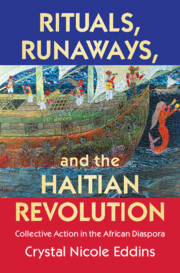Book contents
- Rituals, Runaways, and the Haitian Revolution
- Cambridge Studies on the African Diaspora
- Rituals, Runaways, and the Haitian Revolution
- Copyright page
- Dedication
- Contents
- Figures
- Tables
- Acknowledgements
- Additional material
- Introduction
- I Homelands, Diaspora, and Slave Society
- II Consciousness and Interaction: Cultural Expressions, Networks and Ties, Geographies and Space
- III Collective Action and Revolution
- Conclusion
- Notes
- References
- Index
- References
References
Published online by Cambridge University Press: 14 April 2022
- Rituals, Runaways, and the Haitian Revolution
- Cambridge Studies on the African Diaspora
- Rituals, Runaways, and the Haitian Revolution
- Copyright page
- Dedication
- Contents
- Figures
- Tables
- Acknowledgements
- Additional material
- Introduction
- I Homelands, Diaspora, and Slave Society
- II Consciousness and Interaction: Cultural Expressions, Networks and Ties, Geographies and Space
- III Collective Action and Revolution
- Conclusion
- Notes
- References
- Index
- References
Summary
- Type
- Chapter
- Information
- Rituals, Runaways, and the Haitian RevolutionCollective Action in the African Diaspora, pp. 329 - 354Publisher: Cambridge University PressPrint publication year: 2022
- Creative Commons
- This content is Open Access and distributed under the terms of the Creative Commons Attribution licence CC-BY-NC-ND 4.0 https://creativecommons.org/cclicenses/



